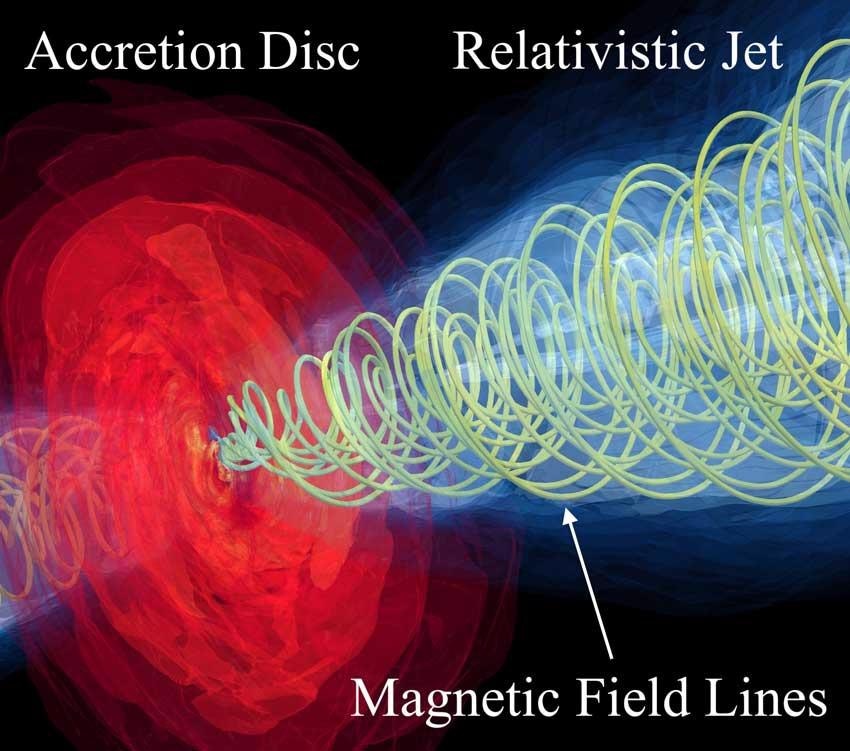Astronomers have observed a massive jet of particles emitted by the Messier 87 (M87) giant galaxy in different wavelengths.
 Along the magnetic field lines, the particles are accelerated so efficiently that they form a jet out to scales of 6000 light-years in the case of M87. Image Credit: Alejandro Cruz-Osorio.
Along the magnetic field lines, the particles are accelerated so efficiently that they form a jet out to scales of 6000 light-years in the case of M87. Image Credit: Alejandro Cruz-Osorio.
Dr. Alejandro Cruz-Osorio and Professor Luciano Rezzolla from Goethe University Frankfurt collaborated with an international research team and successfully developed a theoretical model of the morphology of this jet with the help of complex supercomputer calculations. Images obtained from these calculations offer an unparalleled match with astronomical observations, confirming Einstein’s theory of general relativity.
The M87 galaxy is situated in the Virgo constellation, 55 million light-years away from Earth. With 12,000 globular clusters, it is a giant galaxy that makes the Milky Way’s 200 globular clusters seem small in comparison.
At the center of M87 lies a black hole with a mass of six and a half billion solar masses. It is the first-ever black hole to have been imaged by the international research collaboration Event Horizon Telescope in 2019.
The black hole, named M87*, emits a jet of plasma — a so-called relativistic jet — almost at the speed of light, on a scale of 6,000 light-years. The enormous energy required to power this jet possibly arises from the black hole’s gravitational pull. However, there is no complete understanding of how such a jet is formed and what maintains its stablity across the huge distance.
The M87* black hole attracts matter that rotates in a disk in much smaller orbits until it is gobbled by the black hole. The jet is emitted from the center of the accretion disk around M87. Goethe University theoretical physicists, as well as researchers from Europe, the United States and China, recently modeled this region in great detail.
Highly advanced three-dimensional supercomputer simulations involving a million CPU hours per simulation were used and the equations of general relativity by Albert Einstein, the equations of electromagnetism by James Maxwell, and the equations of fluid dynamics by Leonhard Euler were solved simultaneously.
The outcome was a model where the values estimated for the temperatures, the magnetic fields and the matter densities correspond very well with those calculated from the astronomical observations.
With this framework, the researchers could monitor the complex motion of photons in the curved spacetime of the jet’s innermost region and convert this into radio images. Then, they could compare these computer-modeled images with the observations performed with several radio telescopes and satellites over the last 30 years.
Our theoretical model of the electromagnetic emission and of the jet morphology of M87 matches surprisingly well with the observations in the radio, optical and infrared spectra. This tells us that the supermassive black hole M87* is probably highly rotating and that the plasma is strongly magnetized in the jet, accelerating particles out to scales of thousands of light years.
Dr. Alejandro Cruz-Osorio, Study Lead Author, Goethe University Frankfurt
According to Professor Luciano Rezzolla, Institute for Theoretical Physics at Goethe University Frankfurt, “The fact that the images we calculated are so close to the astronomical observations is another important confirmation that Einstein’s theory of general relativity is the most precise and natural explanation for the existence of supermassive black holes in the centre of galaxies.”
While there is still room for alternative explanations, the findings of our study have made this room much smaller.
Luciano Rezzolla, Professor, Institute for Theoretical Physics, Goethe University Frankfurt
Journal Reference:
Cruz-Osorio, A., et al. (2021) State-of-the-art energetic and morphological modelling of the launching site of the M87 jet. Nature Astronomy. doi.org/10.1038/s41550-021-01506-w.